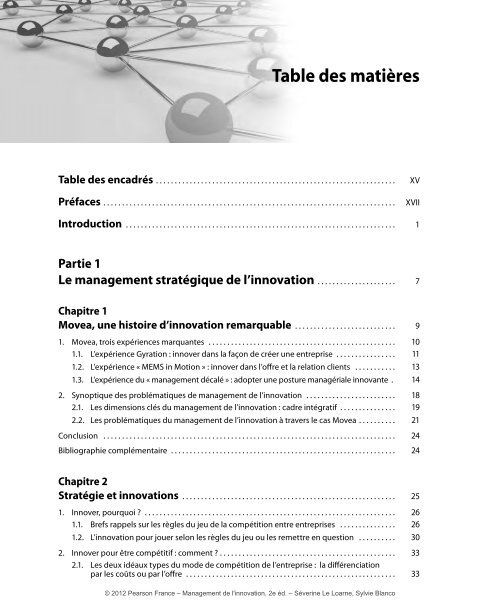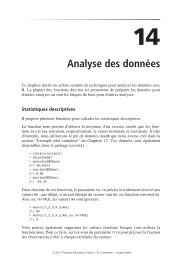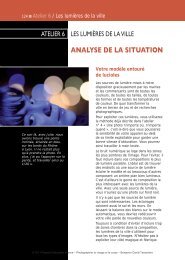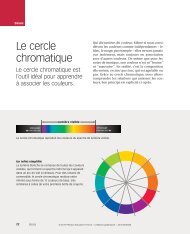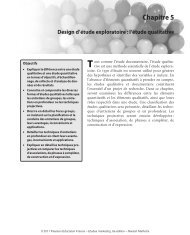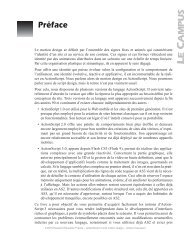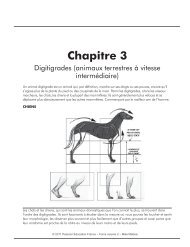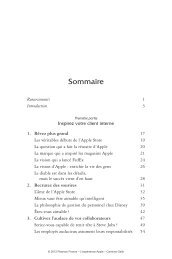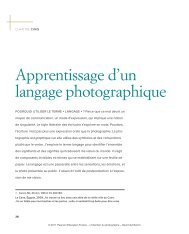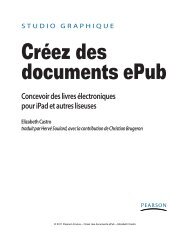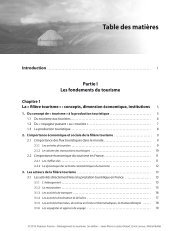Management de l'innovation - Pearson
Management de l'innovation - Pearson
Management de l'innovation - Pearson
Create successful ePaper yourself
Turn your PDF publications into a flip-book with our unique Google optimized e-Paper software.
IV<strong>Management</strong> <strong>de</strong> l’innovation2.2. Catégorisation <strong>de</strong> l’innovation selon l’objet : innovation <strong>de</strong> produit vs innovation<strong>de</strong> procédé . . . . . . . . . . . . . . . . . . . . . . . . . . . . . . . . . . . . . . . . . . . . . . . . . . . . . . . . . . . . . . . . . . . . . 343. Innover : avec qui ? . . . . . . . . . . . . . . . . . . . . . . . . . . . . . . . . . . . . . . . . . . . . . . . . . . . . . . . . . . . . . . . . . . . 353.1. L’entreprise et sa chaîne <strong>de</strong> valeur . . . . . . . . . . . . . . . . . . . . . . . . . . . . . . . . . . . . . . . . . . . . . . . . 363.2. Catégorisation <strong>de</strong> l’innovation selon son intensité . . . . . . . . . . . . . . . . . . . . . . . . . . . . . . . . . 374. Vers une compétition entre entreprises par l’innovation ? .. . . . . . . . . . . . . . . . . . . . . . . . . . . . . . . 394.1. L’innovation : moteur <strong>de</strong> l’hypercompétition ? .. . . . . . . . . . . . . . . . . . . . . . . . . . . . . . . . . . . . 394.2. Les limites <strong>de</strong> l’hypercompétition .. . . . . . . . . . . . . . . . . . . . . . . . . . . . . . . . . . . . . . . . . . . . . . . . 414.3. Quel type d’innovation pour favoriser quelle manœuvre stratégique ? .. . . . . . . . . . . . . . 43Conclusion .. . . . . . . . . . . . . . . . . . . . . . . . . . . . . . . . . . . . . . . . . . . . . . . . . . . . . . . . . . . . . . . . . . . . . . . . . . . . . 44Bibliographie complémentaire .. . . . . . . . . . . . . . . . . . . . . . . . . . . . . . . . . . . . . . . . . . . . . . . . . . . . . . . . . . . 45Étu<strong>de</strong> <strong>de</strong> cas .. . . . . . . . . . . . . . . . . . . . . . . . . . . . . . . . . . . . . . . . . . . . . . . . . . . . . . . . . . . . . . . . . . . . . . . . . . . . 46Chapitre 3Sources et processus d’innovation . . . . . . . . . . . . . . . . . . . . . . . . . . . . . . . . . . . . . . . . . . . 491. La science et la technologie : les premiers moteurs <strong>de</strong> l’innovation .. . . . . . . . . . . . . . . . . . . . . . 501.1. Approche macroéconomique : la science, vecteur d’innovations .. . . . . . . . . . . . . . . . . . . 511.2. Les services <strong>de</strong> R&D, lieux d’innovation .. . . . . . . . . . . . . . . . . . . . . . . . . . . . . . . . . . . . . . . . . . . 541.3. Les limites du processus d’innovation linéaire poussé par la technologie .. . . . . . . . . . . . 582. Les utilisateurs : un second moteur d’innovation .. . . . . . . . . . . . . . . . . . . . . . . . . . . . . . . . . . . . . . . 602.1. L’usage génère <strong>de</strong>s connaissances pour améliorer le produit .et en développer d’autres ! .. . . . . . . . . . . . . . . . . . . . . . . . . . . . . . . . . . . . . . . . . . . . . . . . . . . . . . 602.2. Le processus d’innovation itératif, tiré par le marché .. . . . . . . . . . . . . . . . . . . . . . . . . . . . . . . 613. Gérer le processus et les sources d’innovation . . . . . . . . . . . . . . . . . . . . . . . . . . . . . . . . . . . . . . . . . . 673.1. Un processus portant à la fois sur l’exploration et l’exploitation <strong>de</strong> l’idée d’innovation . 673.2. L’intégration <strong>de</strong> l’utilisateur pour une innovation adaptée au marché .. . . . . . . . . . . . . . . 703.3. Un processus permettant à l’innovation d’être là « au bon moment » .. . . . . . . . . . . . . . . 73Conclusion .. . . . . . . . . . . . . . . . . . . . . . . . . . . . . . . . . . . . . . . . . . . . . . . . . . . . . . . . . . . . . . . . . . . . . . . . . . . . . 75Bibliographie complémentaire .. . . . . . . . . . . . . . . . . . . . . . . . . . . . . . . . . . . . . . . . . . . . . . . . . . . . . . . . . . . 75Étu<strong>de</strong> <strong>de</strong> cas .. . . . . . . . . . . . . . . . . . . . . . . . . . . . . . . . . . . . . . . . . . . . . . . . . . . . . . . . . . . . . . . . . . . . . . . . . . . . 76Partie 2L’exploration pour l’innovation .. . . . . . . . . . . . . . . . . . . . . . . . . . . . . . . . . . . . . . . . 79Chapitre 4Dynamique et espace d’innovation . . . . . . . . . . . . . . . . . . . . . . . . . . . . . . . . . . . . . . . . . . 811. Les dynamiques d’innovation . . . . . . . . . . . . . . . . . . . . . . . . . . . . . . . . . . . . . . . . . . . . . . . . . . . . . . . . . 821.1. Le progrès technologique .. . . . . . . . . . . . . . . . . . . . . . . . . . . . . . . . . . . . . . . . . . . . . . . . . . . . . . . 82© 2012 <strong>Pearson</strong> France – <strong>Management</strong> <strong>de</strong> <strong>l'innovation</strong>, 2e éd. – Séverine Le Loarne, Sylvie Blanco
Table <strong>de</strong>s matièresV1.2. La dynamique d’innovation industrielle .. . . . . . . . . . . . . . . . . . . . . . . . . . . . . . . . . . . . . . . . . . 841.3. Le phénomène <strong>de</strong> rupture . . . . . . . . . . . . . . . . . . . . . . . . . . . . . . . . . . . . . . . . . . . . . . . . . . . . . . . 862. Espaces d’innovation et anticipation .. . . . . . . . . . . . . . . . . . . . . . . . . . . . . . . . . . . . . . . . . . . . . . . . . . 882.1. Un espace d’innovation en quatre zones . . . . . . . . . . . . . . . . . . . . . . . . . . . . . . . . . . . . . . . . . . 892.2. Les thématiques d’innovation .. . . . . . . . . . . . . . . . . . . . . . . . . . . . . . . . . . . . . . . . . . . . . . . . . . . 912.3. Les pratiques et capacités d’anticipation . . . . . . . . . . . . . . . . . . . . . . . . . . . . . . . . . . . . . . . . . . 923. Illustration pratique : le cas <strong>de</strong> l’affichage publicitaire .. . . . . . . . . . . . . . . . . . . . . . . . . . . . . . . . . . . 953.1. Dynamique d’innovation .. . . . . . . . . . . . . . . . . . . . . . . . . . . . . . . . . . . . . . . . . . . . . . . . . . . . . . . . 953.2. Megatrends et espace d’innovation . . . . . . . . . . . . . . . . . . . . . . . . . . . . . . . . . . . . . . . . . . . . . . . 973.3. Thématiques et métaconcepts . . . . . . . . . . . . . . . . . . . . . . . . . . . . . . . . . . . . . . . . . . . . . . . . . . . 99Conclusion .. . . . . . . . . . . . . . . . . . . . . . . . . . . . . . . . . . . . . . . . . . . . . . . . . . . . . . . . . . . . . . . . . . . . . . . . . . . . . 101Bibliographie complémentaire .. . . . . . . . . . . . . . . . . . . . . . . . . . . . . . . . . . . . . . . . . . . . . . . . . . . . . . . . . . . 102Étu<strong>de</strong> <strong>de</strong> cas .. . . . . . . . . . . . . . . . . . . . . . . . . . . . . . . . . . . . . . . . . . . . . . . . . . . . . . . . . . . . . . . . . . . . . . . . . . . . 103Chapitre 5Gérer la créativité en entreprise . . . . . . . . . . . . . . . . . . . . . . . . . . . . . . . . . . . . . . . . . . . . . . 1071. La créativité individuelle : pilier <strong>de</strong> l’émergence <strong>de</strong>s idées .. . . . . . . . . . . . . . . . . . . . . . . . . . . . . . . 1081.1. Principes généraux <strong>de</strong> la créativité individuelle .. . . . . . . . . . . . . . . . . . . . . . . . . . . . . . . . . . . 1081.2. Les sources <strong>de</strong> la créativité individuelle .. . . . . . . . . . . . . . . . . . . . . . . . . . . . . . . . . . . . . . . . . . . 1122. Créativité individuelle : la responsabilité <strong>de</strong> l’organisation . . . . . . . . . . . . . . . . . . . . . . . . . . . . . . . 1172.1. Les acteurs clés <strong>de</strong> la créativité organisationnelle et <strong>de</strong> la génération <strong>de</strong>s idées .. . . . . . 1172.2. Les managers : leur mission pour générer cette créativité .. . . . . . . . . . . . . . . . . . . . . . . . . . 1263. Des outils pour stimuler la créativité . . . . . . . . . . . . . . . . . . . . . . . . . . . . . . . . . . . . . . . . . . . . . . . . . . . 1293.1. Des outils orientées vers la créativité individuelle .. . . . . . . . . . . . . . . . . . . . . . . . . . . . . . . . . 1293.2. Des outils orientés vers la créativité organisationnelle .. . . . . . . . . . . . . . . . . . . . . . . . . . . . . 132Conclusion .. . . . . . . . . . . . . . . . . . . . . . . . . . . . . . . . . . . . . . . . . . . . . . . . . . . . . . . . . . . . . . . . . . . . . . . . . . . . . 137Bibliographie complémentaire .. . . . . . . . . . . . . . . . . . . . . . . . . . . . . . . . . . . . . . . . . . . . . . . . . . . . . . . . . . . 137Étu<strong>de</strong> <strong>de</strong> cas .. . . . . . . . . . . . . . . . . . . . . . . . . . . . . . . . . . . . . . . . . . . . . . . . . . . . . . . . . . . . . . . . . . . . . . . . . . . . 139Chapitre 6Exploration et collaboration .. . . . . . . . . . . . . . . . . . . . . . . . . . . . . . . . . . . . . . . . . . . . . . . . . . 1411. Penser les innovations <strong>de</strong> rupture .. . . . . . . . . . . . . . . . . . . . . . . . . . . . . . . . . . . . . . . . . . . . . . . . . . . . . 1421.1. Spécificités <strong>de</strong>s activités d’exploration . . . . . . . . . . . . . . . . . . . . . . . . . . . . . . . . . . . . . . . . . . . . . 1421.2. Le terrain <strong>de</strong> jeux <strong>de</strong> l’exploration : le champ d’innovation .. . . . . . . . . . . . . . . . . . . . . . . . . 1452. La théorie <strong>de</strong> conception C-K : un effort <strong>de</strong> modélisation <strong>de</strong> l’exploration .. . . . . . . . . . . . . . . . 1482.1. Deux approches pratiques <strong>de</strong> l’innovation .. . . . . . . . . . . . . . . . . . . . . . . . . . . . . . . . . . . . . . . . 1482.2. Combiner créativité et conception : la théorie C-K (Concept‐Knowledge) .. . . . . . . . . . . . . 1503. L’exploration collective . . . . . . . . . . . . . . . . . . . . . . . . . . . . . . . . . . . . . . . . . . . . . . . . . . . . . . . . . . . . . . . 1523.1. Les partenariats d’exploration .. . . . . . . . . . . . . . . . . . . . . . . . . . . . . . . . . . . . . . . . . . . . . . . . . . . 1523.2. Gui<strong>de</strong> pratique <strong>de</strong> la gestion d’un partenariat d’exploration : l’outil OPERA .. . . . . . . . . . 154© 2012 <strong>Pearson</strong> France – <strong>Management</strong> <strong>de</strong> <strong>l'innovation</strong>, 2e éd. – Séverine Le Loarne, Sylvie Blanco
VI<strong>Management</strong> <strong>de</strong> l’innovationConclusion .. . . . . . . . . . . . . . . . . . . . . . . . . . . . . . . . . . . . . . . . . . . . . . . . . . . . . . . . . . . . . . . . . . . . . . . . . . . . . 159Bibliographie complémentaire .. . . . . . . . . . . . . . . . . . . . . . . . . . . . . . . . . . . . . . . . . . . . . . . . . . . . . . . . . . . 159Exercice .. . . . . . . . . . . . . . . . . . . . . . . . . . . . . . . . . . . . . . . . . . . . . . . . . . . . . . . . . . . . . . . . . . . . . . . . . . . . . . . . 161Partie 3La démonstration <strong>de</strong> l’innovation. . . . . . . . . . . . . . . . . . . . . . . . . . . . . . . . . . . . . 163Chapitre 7Marketing <strong>de</strong> l’innovation .. . . . . . . . . . . . . . . . . . . . . . . . . . . . . . . . . . . . . . . . . . . . . . . . . . . . . 1651. Les concepts fondamentaux <strong>de</strong> l’approche marché en innovation .. . . . . . . . . . . . . . . . . . . . . . . 1671.1. Marché et innovation .. . . . . . . . . . . . . . . . . . . . . . . . . . . . . . . . . . . . . . . . . . . . . . . . . . . . . . . . . . . 1671.2. La valeur <strong>de</strong> l’innovation du point <strong>de</strong> vue du client .. . . . . . . . . . . . . . . . . . . . . . . . . . . . . . . . 1711.3. L’offre innovante . . . . . . . . . . . . . . . . . . . . . . . . . . . . . . . . . . . . . . . . . . . . . . . . . . . . . . . . . . . . . . . . 1722. Les démarches et pratiques du marketing <strong>de</strong> l’innovation . . . . . . . . . . . . . . . . . . . . . . . . . . . . . . . 1752.1. Vue d’ensemble <strong>de</strong> la démarche <strong>de</strong> marketing <strong>de</strong> l’innovation .. . . . . . . . . . . . . . . . . . . . . 1752.2. La conviction <strong>de</strong> l’existence d’un marché prometteur . . . . . . . . . . . . . . . . . . . . . . . . . . . . . . 1772.3. La démonstration <strong>de</strong> faisabilité marketing et la préparation du lancement .. . . . . . . . . . 1803. Limites et perspectives .. . . . . . . . . . . . . . . . . . . . . . . . . . . . . . . . . . . . . . . . . . . . . . . . . . . . . . . . . . . . . . . 1823.1. Compenser les démarches marketing actuelles par une plus gran<strong>de</strong> expérience terrain . 1833.2. L’orientation marché, déterminant <strong>de</strong> la capacité d’innovation .. . . . . . . . . . . . . . . . . . . . . 1863.3. Au-<strong>de</strong>là <strong>de</strong>s liens avec la R&D et le <strong>de</strong>sign : les services et la marque .. . . . . . . . . . . . . . . . . . . . . . 187Conclusion .. . . . . . . . . . . . . . . . . . . . . . . . . . . . . . . . . . . . . . . . . . . . . . . . . . . . . . . . . . . . . . . . . . . . . . . . . . . . . 190Bibliographie complémentaire .. . . . . . . . . . . . . . . . . . . . . . . . . . . . . . . . . . . . . . . . . . . . . . . . . . . . . . . . . . . 190Étu<strong>de</strong> <strong>de</strong> cas .. . . . . . . . . . . . . . . . . . . . . . . . . . . . . . . . . . . . . . . . . . . . . . . . . . . . . . . . . . . . . . . . . . . . . . . . . . . . 191Chapitre 8Concevoir un business mo<strong>de</strong>l pour l’innovation .. . . . . . . . . . . . . . . . . . . . . . . . . . 1951. Le business mo<strong>de</strong>l : comment l’entreprise crée et capture <strong>de</strong> la valeur .. . . . . . . . . . . . . . . . . . . . 1961.1. La proposition <strong>de</strong> valeur faite aux clients .. . . . . . . . . . . . . . . . . . . . . . . . . . . . . . . . . . . . . . . . . 1971.2. Le réseau <strong>de</strong> valeur .. . . . . . . . . . . . . . . . . . . . . . . . . . . . . . . . . . . . . . . . . . . . . . . . . . . . . . . . . . . . . 1981.3. Les ressources et moyens organisationnels .. . . . . . . . . . . . . . . . . . . . . . . . . . . . . . . . . . . . . . . 1991.4. Le modèle <strong>de</strong> profit .. . . . . . . . . . . . . . . . . . . . . . . . . . . . . . . . . . . . . . . . . . . . . . . . . . . . . . . . . . . . . 2002. Positionner le business mo<strong>de</strong>l dans la chaîne <strong>de</strong> valeur externe .. . . . . . . . . . . . . . . . . . . . . . . . . . 2022.1. La chaîne <strong>de</strong> valeur externe <strong>de</strong> l’industrie . . . . . . . . . . . . . . . . . . . . . . . . . . . . . . . . . . . . . . . . . 2022.2. Une typologie <strong>de</strong>s business mo<strong>de</strong>ls .. . . . . . . . . . . . . . . . . . . . . . . . . . . . . . . . . . . . . . . . . . . . . . . 2042.3. Le choix d’un business mo<strong>de</strong>l adapté à l’innovation .. . . . . . . . . . . . . . . . . . . . . . . . . . . . . . . . 207Conclusion .. . . . . . . . . . . . . . . . . . . . . . . . . . . . . . . . . . . . . . . . . . . . . . . . . . . . . . . . . . . . . . . . . . . . . . . . . . . . . 210Bibliographie complémentaire .. . . . . . . . . . . . . . . . . . . . . . . . . . . . . . . . . . . . . . . . . . . . . . . . . . . . . . . . . . . 211Étu<strong>de</strong> <strong>de</strong> cas .. . . . . . . . . . . . . . . . . . . . . . . . . . . . . . . . . . . . . . . . . . . . . . . . . . . . . . . . . . . . . . . . . . . . . . . . . . . . 212© 2012 <strong>Pearson</strong> France – <strong>Management</strong> <strong>de</strong> <strong>l'innovation</strong>, 2e éd. – Séverine Le Loarne, Sylvie Blanco
Table <strong>de</strong>s matièresVIIChapitre 9Intégration <strong>de</strong> l’innovation et choix d’organisation .. . . . . . . . . . . . . . . . . . . . . 2151. Le transfert du projet vers les activités opérationnelles .. . . . . . . . . . . . . . . . . . . . . . . . . . . . . . . . . 2161.1. La problématique du transfert et <strong>de</strong> l’intégration <strong>de</strong> l’innovation dans l’organisation . . 2171.2. La question <strong>de</strong> l’interface entre innovation et plate-forme opérationnelle . . . . . . . . . . . 2191.3. Leviers d’intégration <strong>de</strong> l’innovation .. . . . . . . . . . . . . . . . . . . . . . . . . . . . . . . . . . . . . . . . . . . . . 2222. Démarche associant porteurs d’innovation et déci<strong>de</strong>urs : l’approche Kibis © .. . . . . . . . . . . . . . 2262.1. Vue d’ensemble <strong>de</strong> la démarche Kibis © .. . . . . . . . . . . . . . . . . . . . . . . . . . . . . . . . . . . . . . . . . . . 2272.2. Cartographie <strong>de</strong>s tensions et <strong>de</strong>s synergies .. . . . . . . . . . . . . . . . . . . . . . . . . . . . . . . . . . . . . . . 2282.3. Matrice <strong>de</strong> compatibilité et options organisationnelles .. . . . . . . . . . . . . . . . . . . . . . . . . . . . 2293. Un retour d’expérience : le cas « Drill it right », Schnei<strong>de</strong>r Electric .. . . . . . . . . . . . . . . . . . . . . . . . . 2303.1. L’entreprise et l’innovation potentielle . . . . . . . . . . . . . . . . . . . . . . . . . . . . . . . . . . . . . . . . . . . . 2303.2. Les résultats <strong>de</strong>s ateliers Kibis © « Drill it right » .. . . . . . . . . . . . . . . . . . . . . . . . . . . . . . . . . . . . . 2323.3. Utilité et impact perçus <strong>de</strong> la démarche .. . . . . . . . . . . . . . . . . . . . . . . . . . . . . . . . . . . . . . . . . . 234Conclusion .. . . . . . . . . . . . . . . . . . . . . . . . . . . . . . . . . . . . . . . . . . . . . . . . . . . . . . . . . . . . . . . . . . . . . . . . . . . . . 235Bibliographie complémentaire .. . . . . . . . . . . . . . . . . . . . . . . . . . . . . . . . . . . . . . . . . . . . . . . . . . . . . . . . . . . 236Étu<strong>de</strong> <strong>de</strong> cas .. . . . . . . . . . . . . . . . . . . . . . . . . . . . . . . . . . . . . . . . . . . . . . . . . . . . . . . . . . . . . . . . . . . . . . . . . . . . 237Partie 4La réalisation <strong>de</strong> l’innovation .. . . . . . . . . . . . . . . . . . . . . . . . . . . . . . . . . . . . . . . . . . . 239Chapitre 10Sélection stratégique <strong>de</strong> l’innovation . . . . . . . . . . . . . . . . . . . . . . . . . . . . . . . . . . . . . . . 2411. Les différentes logiques <strong>de</strong> la sélection en innovation .. . . . . . . . . . . . . . . . . . . . . . . . . . . . . . . . . . 2421.1. Le schéma VSR : variation, sélection, rétention .. . . . . . . . . . . . . . . . . . . . . . . . . . . . . . . . . . . . 2431.2. Les logiques individuelles et collectives <strong>de</strong> sélection .. . . . . . . . . . . . . . . . . . . . . . . . . . . . . . 2451.3. Les logiques d’écosystème et la sélection <strong>de</strong> l’innovation .. . . . . . . . . . . . . . . . . . . . . . . . . . 2492. Les démarches et pratiques <strong>de</strong> sélection . . . . . . . . . . . . . . . . . . . . . . . . . . . . . . . . . . . . . . . . . . . . . . . 2502.1. Vue d’ensemble <strong>de</strong>s démarches <strong>de</strong> sélection stratégique <strong>de</strong> l’innovation . . . . . . . . . . . . 2512.2. Critères <strong>de</strong> sélection <strong>de</strong> l’innovation . . . . . . . . . . . . . . . . . . . . . . . . . . . . . . . . . . . . . . . . . . . . . . . 2522.3. Choix <strong>de</strong>s partenaires amont <strong>de</strong> l’innovation . . . . . . . . . . . . . . . . . . . . . . . . . . . . . . . . . . . . . . 2533. Pour une évolution <strong>de</strong>s pratiques stratégiques .. . . . . . . . . . . . . . . . . . . . . . . . . . . . . . . . . . . . . . . . . 2553.1. Modèle intégratif <strong>de</strong> la sélection stratégique <strong>de</strong> l’innovation .. . . . . . . . . . . . . . . . . . . . . . . 2553.2. Acteurs <strong>de</strong> la sélection stratégique .. . . . . . . . . . . . . . . . . . . . . . . . . . . . . . . . . . . . . . . . . . . . . . . 2573.3. Nouveau management stratégique face à l’innovation .. . . . . . . . . . . . . . . . . . . . . . . . . . . . 258Conclusion.. . . . . . . . . . . . . . . . . . . . . . . . . . . . . . . . . . . . . . . . . . . . . . . . . . . . . . . . . . . . . . . . . . . . . . . . . . . . . . 258Bibliographie complémentaire .. . . . . . . . . . . . . . . . . . . . . . . . . . . . . . . . . . . . . . . . . . . . . . . . . . . . . . . . . . . 259Étu<strong>de</strong> <strong>de</strong> cas .. . . . . . . . . . . . . . . . . . . . . . . . . . . . . . . . . . . . . . . . . . . . . . . . . . . . . . . . . . . . . . . . . . . . . . . . . . . . 260© 2012 <strong>Pearson</strong> France – <strong>Management</strong> <strong>de</strong> <strong>l'innovation</strong>, 2e éd. – Séverine Le Loarne, Sylvie Blanco
VIII<strong>Management</strong> <strong>de</strong> l’innovationChapitre 11Organiser et manager un projet d’innovation .. . . . . . . . . . . . . . . . . . . . . . . . . . . . 2631. La vie du projet d’innovation : une idée <strong>de</strong> départ claire mais un chemin mouvementé . . . . 2641.1. Le projet d’innovation, une partie seulement du processus d’innovation .. . . . . . . . . . . . 2641.2. Les soubresauts du projet d’innovation . . . . . . . . . . . . . . . . . . . . . . . . . . . . . . . . . . . . . . . . . . . 2661.3. Les enjeux et caractéristiques d’un projet d’innovation .. . . . . . . . . . . . . . . . . . . . . . . . . . . . 2672. La place du projet dans l’organisation .. . . . . . . . . . . . . . . . . . . . . . . . . . . . . . . . . . . . . . . . . . . . . . . . . 2692.1. Des structures plus ou moins innovantes .. . . . . . . . . . . . . . . . . . . . . . . . . . . . . . . . . . . . . . . . . 2692.2. Le projet, une intégration plus ou moins forte dans l’organisation .. . . . . . . . . . . . . . . . . . 2703. La gestion du projet au quotidien .. . . . . . . . . . . . . . . . . . . . . . . . . . . . . . . . . . . . . . . . . . . . . . . . . . . . . 2723.1. Le projet : entre mo<strong>de</strong> communautaire et mo<strong>de</strong> complémentaire .. . . . . . . . . . . . . . . . . . 2723.2. Le projet au quotidien .. . . . . . . . . . . . . . . . . . . . . . . . . . . . . . . . . . . . . . . . . . . . . . . . . . . . . . . . . . 277Conclusion .. . . . . . . . . . . . . . . . . . . . . . . . . . . . . . . . . . . . . . . . . . . . . . . . . . . . . . . . . . . . . . . . . . . . . . . . . . . . . 279Bibliographie complémentaire .. . . . . . . . . . . . . . . . . . . . . . . . . . . . . . . . . . . . . . . . . . . . . . . . . . . . . . . . . . . 280Étu<strong>de</strong> <strong>de</strong> cas .. . . . . . . . . . . . . . . . . . . . . . . . . . . . . . . . . . . . . . . . . . . . . . . . . . . . . . . . . . . . . . . . . . . . . . . . . . . . 281Chapitre 12Le financement <strong>de</strong> l’innovation . . . . . . . . . . . . . . . . . . . . . . . . . . . . . . . . . . . . . . . . . . . . . . . 2831. Le financement <strong>de</strong> la croissance <strong>de</strong>s entreprises innovantes .. . . . . . . . . . . . . . . . . . . . . . . . . . . . . . . . . . . . . 2851.1. La chaîne du financement .. . . . . . . . . . . . . . . . . . . . . . . . . . . . . . . . . . . . . . . . . . . . . . . . . . . . . . . 2861.2. Le soutien public au financement <strong>de</strong> la R&D .. . . . . . . . . . . . . . . . . . . . . . . . . . . . . . . . . . . . . . 2892. Les ai<strong>de</strong>s directes en France et en Europe . . . . . . . . . . . . . . . . . . . . . . . . . . . . . . . . . . . . . . . . . . . . . . 2912.1. Panorama <strong>de</strong>s ai<strong>de</strong>s directes . . . . . . . . . . . . . . . . . . . . . . . . . . . . . . . . . . . . . . . . . . . . . . . . . . . . . 2912.2. Ai<strong>de</strong> pour la faisabilité <strong>de</strong> l’innovation . . . . . . . . . . . . . . . . . . . . . . . . . . . . . . . . . . . . . . . . . . . . 2932.3. Agence nationale <strong>de</strong> la recherche (ANR) .. . . . . . . . . . . . . . . . . . . . . . . . . . . . . . . . . . . . . . . . . . 2952.4. Fonds unique interministériel (FUI) .. . . . . . . . . . . . . . . . . . . . . . . . . . . . . . . . . . . . . . . . . . . . . . . 2972.5. Programme cadre <strong>de</strong> recherche et développement (PCRD) . . . . . . . . . . . . . . . . . . . . . . . . . . 2993. Les ai<strong>de</strong>s indirectes : crédit d’impôt recherche et statut <strong>de</strong> Jeune entreprise innovante . . . . 3023.1. Crédit d’impôt recherche (CIR) .. . . . . . . . . . . . . . . . . . . . . . . . . . . . . . . . . . . . . . . . . . . . . . . . . . . 3023.2. Statut <strong>de</strong> Jeune entreprise innovante . . . . . . . . . . . . . . . . . . . . . . . . . . . . . . . . . . . . . . . . . . . . . 306Conclusion .. . . . . . . . . . . . . . . . . . . . . . . . . . . . . . . . . . . . . . . . . . . . . . . . . . . . . . . . . . . . . . . . . . . . . . . . . . . . . 309Étu<strong>de</strong> <strong>de</strong> cas .. . . . . . . . . . . . . . . . . . . . . . . . . . . . . . . . . . . . . . . . . . . . . . . . . . . . . . . . . . . . . . . . . . . . . . . . . . . . 310Partie 5La diffusion <strong>de</strong> l’innovation.. . . . . . . . . . . . . . . . . . . . . . . . . . . . . . . . . . . . . . . . . . . . . . 313Chapitre 13Protéger et valoriser l’innovation .. . . . . . . . . . . . . . . . . . . . . . . . . . . . . . . . . . . . . . . . . . . . 3151. Protéger son innovation par la PI . . . . . . . . . . . . . . . . . . . . . . . . . . . . . . . . . . . . . . . . . . . . . . . . . . . . . . 316© 2012 <strong>Pearson</strong> France – <strong>Management</strong> <strong>de</strong> <strong>l'innovation</strong>, 2e éd. – Séverine Le Loarne, Sylvie Blanco
Table <strong>de</strong>s matièresIX1.1. La PI : les instruments juridiques .. . . . . . . . . . . . . . . . . . . . . . . . . . . . . . . . . . . . . . . . . . . . . . . . . 3161.2. La PI : les bonnes pratiques .. . . . . . . . . . . . . . . . . . . . . . . . . . . . . . . . . . . . . . . . . . . . . . . . . . . . . . 3232. Valoriser son innovation par la PI . . . . . . . . . . . . . . . . . . . . . . . . . . . . . . . . . . . . . . . . . . . . . . . . . . . . . . 3292.1. Valoriser l’innovation par la PI : les instruments juridiques . . . . . . . . . . . . . . . . . . . . . . . . . . 3292.2. Valoriser l’innovation par la PI : les bonnes pratiques .. . . . . . . . . . . . . . . . . . . . . . . . . . . . . . 3323. Élaborer sa stratégie <strong>de</strong> PI .. . . . . . . . . . . . . . . . . . . . . . . . . . . . . . . . . . . . . . . . . . . . . . . . . . . . . . . . . . . . 3333.1. Élaborer sa stratégie en fonction <strong>de</strong> l’industrie .. . . . . . . . . . . . . . . . . . . . . . . . . . . . . . . . . . . . 3333.2. Élaborer une stratégie en fonction <strong>de</strong>s ressources <strong>de</strong> l’entreprise innovante .. . . . . . . . . 335Conclusion .. . . . . . . . . . . . . . . . . . . . . . . . . . . . . . . . . . . . . . . . . . . . . . . . . . . . . . . . . . . . . . . . . . . . . . . . . . . . . 339Bibliographie complémentaire . . . . . . . . . . . . . . . . . . . . . . . . . . . . . . . . . . . . . . . . . . . . . . . . . . . . . . . . . . . 340Étu<strong>de</strong> <strong>de</strong> cas .. . . . . . . . . . . . . . . . . . . . . . . . . . . . . . . . . . . . . . . . . . . . . . . . . . . . . . . . . . . . . . . . . . . . . . . . . . . . 341Chapitre 14Stratégie <strong>de</strong> diffusion <strong>de</strong> l’innovation .. . . . . . . . . . . . . . . . . . . . . . . . . . . . . . . . . . . . . . 3431. Se méfier <strong>de</strong>s idées reçues sur la diffusion <strong>de</strong> l’innovation . . . . . . . . . . . . . . . . . . . . . . . . . . . . . . . 3441.1. La cible touchée n’est pas toujours celle anticipée par les étu<strong>de</strong>s <strong>de</strong> marché . . . . . . . . . 3441.2. L’innovation est complètement détournée dans l’usage .. . . . . . . . . . . . . . . . . . . . . . . . . . . 3441.3. Un retard « à l’allumage » signifie l’échec définitif <strong>de</strong> l’innovation .. . . . . . . . . . . . . . . . . . . 3451.4. C’est le premier entrant qui récolte la plus forte rente . . . . . . . . . . . . . . . . . . . . . . . . . . . . . . 3452. Formuler sa stratégie <strong>de</strong> diffusion : les gran<strong>de</strong>s composantes .. . . . . . . . . . . . . . . . . . . . . . . . . . . 3472.1. À quel moment faire démarrer la courbe et à quel moment entrer sur la courbe ? .. . . . 3482.2. Estimer la durée pour récolter la rente <strong>de</strong> l’innovation .. . . . . . . . . . . . . . . . . . . . . . . . . . . . . 3482.3. Relancer la courbe .. . . . . . . . . . . . . . . . . . . . . . . . . . . . . . . . . . . . . . . . . . . . . . . . . . . . . . . . . . . . . . 3492.4. I<strong>de</strong>ntifier ses partenaires pour ai<strong>de</strong>r à la structuration <strong>de</strong> la courbe .. . . . . . . . . . . . . . . . . 3503. Créer <strong>de</strong>s réseaux d’innovation pour concrétiser la stratégie <strong>de</strong> diffusion . . . . . . . . . . . . . . . . . 3513.1. Concevoir les réseaux externes pour innover . . . . . . . . . . . . . . . . . . . . . . . . . . . . . . . . . . . . . . 3513.2. Organiser et piloter les réseaux externes pour innover : comment ? .. . . . . . . . . . . . . . . . . 356Conclusion .. . . . . . . . . . . . . . . . . . . . . . . . . . . . . . . . . . . . . . . . . . . . . . . . . . . . . . . . . . . . . . . . . . . . . . . . . . . . . 361Bibliographie complémentaire .. . . . . . . . . . . . . . . . . . . . . . . . . . . . . . . . . . . . . . . . . . . . . . . . . . . . . . . . . . . 361Étu<strong>de</strong> <strong>de</strong> cas .. . . . . . . . . . . . . . . . . . . . . . . . . . . . . . . . . . . . . . . . . . . . . . . . . . . . . . . . . . . . . . . . . . . . . . . . . . . . 362Chapitre 15Capitaliser sur l’expérience d’innovation : construire l’organisationinnovante .. . . . . . . . . . . . . . . . . . . . . . . . . . . . . . . . . . . . . . . . . . . . . . . . . . . . . . . . . . . . . . . . . . . . . . . . . . 3651. L’entreprise innovante : le principe <strong>de</strong> l’hybridation . . . . . . . . . . . . . . . . . . . . . . . . . . . . . . . . . . . . . 3661.1. Notion d’organisation hybri<strong>de</strong> (ou ambi<strong>de</strong>xtre) .. . . . . . . . . . . . . . . . . . . . . . . . . . . . . . . . . . . 3671.2. De quelques principes <strong>de</strong> l’organisation hybri<strong>de</strong> .. . . . . . . . . . . . . . . . . . . . . . . . . . . . . . . . . . 3681.3. De quelques mo<strong>de</strong>s organisationnels <strong>de</strong> l’hybridation .. . . . . . . . . . . . . . . . . . . . . . . . . . . . . 3722. L’improvisation organisationnelle .. . . . . . . . . . . . . . . . . . . . . . . . . . . . . . . . . . . . . . . . . . . . . . . . . . . . . 378© 2012 <strong>Pearson</strong> France – <strong>Management</strong> <strong>de</strong> <strong>l'innovation</strong>, 2e éd. – Séverine Le Loarne, Sylvie Blanco
X<strong>Management</strong> <strong>de</strong> l’innovation3. L’intrapreneuriat ou une gestion <strong>de</strong>s hommes spécifique .. . . . . . . . . . . . . . . . . . . . . . . . . . . . . . . 3803.1. Des comportements intrapreneuriaux . . . . . . . . . . . . . . . . . . . . . . . . . . . . . . . . . . . . . . . . . . . . 3813.2. Une gestion <strong>de</strong>s comportements intrapreneuriaux .. . . . . . . . . . . . . . . . . . . . . . . . . . . . . . . . 382Conclusion.. . . . . . . . . . . . . . . . . . . . . . . . . . . . . . . . . . . . . . . . . . . . . . . . . . . . . . . . . . . . . . . . . . . . . . . . . . . . . . 383Bibliographie complémentaire .. . . . . . . . . . . . . . . . . . . . . . . . . . . . . . . . . . . . . . . . . . . . . . . . . . . . . . . . . . . 384Étu<strong>de</strong> <strong>de</strong> cas .. . . . . . . . . . . . . . . . . . . . . . . . . . . . . . . . . . . . . . . . . . . . . . . . . . . . . . . . . . . . . . . . . . . . . . . . . . . . 385Conclusion générale .. . . . . . . . . . . . . . . . . . . . . . . . . . . . . . . . . . . . . . . . . . . . . . . . . . . . . . . . . . . . . 387Glossaire . . . . . . . . . . . . . . . . . . . . . . . . . . . . . . . . . . . . . . . . . . . . . . . . . . . . . . . . . . . . . . . . . . . . . . . . . . . . 401In<strong>de</strong>x.. . . . . . . . . . . . . . . . . . . . . . . . . . . . . . . . . . . . . . . . . . . . . . . . . . . . . . . . . . . . . . . . . . . . . . . . . . . . . . . . . 409© 2012 <strong>Pearson</strong> France – <strong>Management</strong> <strong>de</strong> <strong>l'innovation</strong>, 2e éd. – Séverine Le Loarne, Sylvie Blanco


